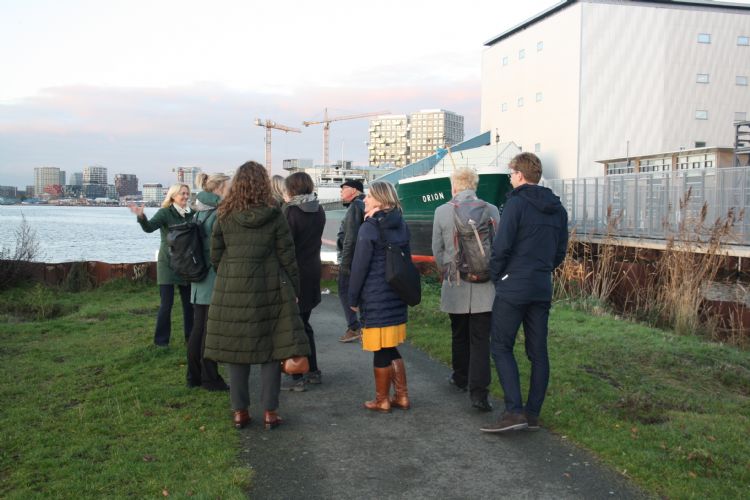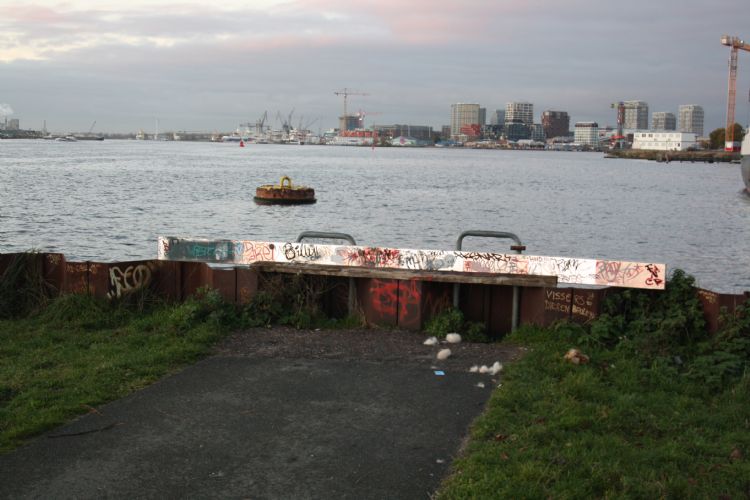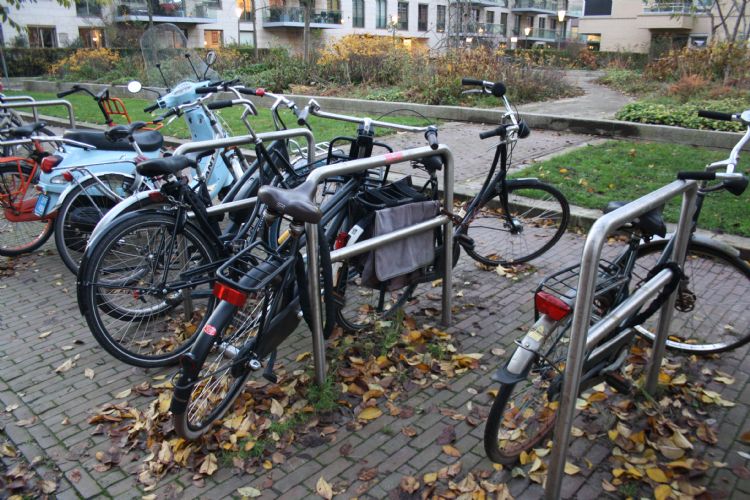 |
| During Martine de Vaan’s walkshop, the pedestrian’s subordinate place in the city becomes clearer. |
Thursday, January 5, 2023
Pedestrians deserve more attention in urban outdoor spaces
While the car is increasingly giving way in the city to more sustainable transport such as train, tram or bicycle, the improvement of infrastructure for the simplest form of mobility is lagging behind. Although we all walk sometimes, not all of our cities are well equipped for pedestrians.
We face enormous challenges in the area of climate and housing. In recent years, attention has increased for accommodation, greenery and meeting in public space. Here, the emphasis is much less on the pedestrian, although he plays an important role. That was the message of “The City on Foot,” an online and physical event that took place on November 29 at the Eye film museum in Amsterdam. Moreover, according to the organizer Goudappel, a consulting firm in the field of mobility, the pedestrian should have a prominent place in (the development of) the public space. The city must become a hiking paradise.
| In recent years, attention has increased for accommodation, greenery and meeting in public space. The emphasis is much less on the pedestrian. | |||
|
Misunderstandings
There are a number of misunderstandings about pedestrians, says first responder Martine de Vaan, program manager City Deal Room for Walking. For example, walking is often not considered a serious form of mobility. Pedestrian movements are therefore rarely measured, which means that data and therefore a targeted approach remain limited.
Another misunderstanding is that in cities people only walk short (creaking) distances and people take bicycles or trams for longer distances. “Of course, that also happens,” says De Vaan, “but around 30 percent of pedestrians in cities still take longer routes, which stretch between 1 and 2.5 kilometers.” Due to this underestimation, some routes are not permanently accessible to pedestrians. “An example is the Leidsche Rijn district of Utrecht, where there are not always sidewalks on the way to the city center and therefore pedestrians have to walk on the cycle path or the tram.”
A third of the list of misunderstandings De Vaan has on hand is that pedestrians only walk in a straight line from A to B. “Walking is mobility, a means of getting from one place to another. But it is much more. people are walking beings; they run for all sorts of different reasons. They also have different needs. Walking can be utilitarian, but also recreational or social, for example. We walk for work, education, care, sports, home, grocery shopping, family, etc. Sometimes we want the fastest route, sometimes the most beautiful, sometimes via a children’s playground, etc. This is why De Vaan advises cities to make this distinction when designing outdoor spaces. “Realize what motivates people to walk. Identify it and include it in the development of the outdoor space.
| people are walking beings | |||
|
Finally, the pedestrian should adapt and simply manage with less space. De Vaan illustrates this misunderstanding with a photo of a (temporarily) parked car that takes up more than half of the sidewalk. There remains a band that you could theoretically cross. “One by one,” De Vaan points out, “and only if you don’t have big bags with you, push a pram or walker in front of you or, for example, if you’re in a wheelchair.” The alternative is to get off the sidewalk, onto the road and walk around the car. ‘Everything is relatively easy if you have good mobility. But let it be the way from a senior apartment to a GP practice. Besides, even if it was the journey between a student apartment and the gymnasium, that’s not how it should be, points out De Vaan. A sidewalk is for walking. Pedestrians, regardless of their physical condition, should not have to take to the streets.
|
City Deal Room for walking the City Deal Room for walking is a partnership in which cities, central government and social and private actors commit to making cities more “walkable”. The participating partners undertake to create the conditions for the “ideal pedestrian city”. Furthermore, the relationship between a walkable environment and issues such as mobility, health, greenery in the city, public space and security will be investigated. The City Deal officially started on December 14, 2020. |
walk shop
Stad+Groen is partnering with De Vaan’s walkshop – a walking workshop – which takes participants on a tour around Eye. Our task is to pay attention to the development of this relatively new district. And the pedestrians? After less than three minutes, we notice that the beginning of the trail is shared with cyclists. Not a problem for the vital group of attendees, but something that certainly needs some attention. Further on, the group literally gets bogged down: a dead end. “Pretty crazy,” said one participant. “Now we have to go back exactly the same way. Wouldn’t it have been a little difficult not to let the road end abruptly here, but to make a circle around it and, for example, to put a bench there?
| “Wouldn’t it have been a bit of an effort not to let the road end here abruptly, but to make a circle of it?” | |||
|
|
||
The band returns and tours the residential area. Here too, in this relatively new district, there is secretly little space for pedestrians. Bike racks take up much of the sidewalk, and improperly parked bikes and scooters around them take up the rest of the pedestrian space. But also fixed parts, such as charging, streetlights and planters, are actually an obstacle for pedestrians. De Vaan points out that often you can’t even walk in pairs next to each other. Further on, there is no sidewalk at all.
Admittedly, without the presentations, relatively little would have been noticed. The other participants also confirm this, who walk down the street without batting an eyelid during the tour to continue walking. “As a pedestrian, you comply; we’re used to it”, says one of the participants on our return to Eye. “It’s time to start thinking about pedestrians differently,” concludes De Vaan. “The pedestrian does not exist. What are the opportunities ? And how do we give priority to the pedestrian? It is high time we sat down together for this.
|
||
Tip the editors

“Food expert. Unapologetic bacon maven. Beer enthusiast. Pop cultureaholic. General travel scholar. Total internet buff.”
 DodoFinance Breaking News Made For You!
DodoFinance Breaking News Made For You!



